Inside The New York Botanical Garden
Posted in Gardening Tips on September 21 2009, by Sonia Uyterhoeven
 |
Sonia Uyterhoeven is Gardener for Public Education. Join her each weekend for home gardening demonstrations on a variety of topics in the Home Gardening Center. |
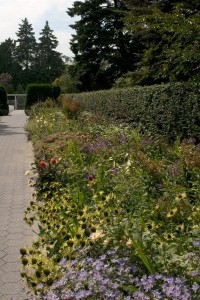 Traditionally, Seasonal Walk at The New York Botanical Garden has been a display of annuals, which kicked off with a massive colorful showing of tulips in spring and reached a crescendo in the summer with an imaginative arrangement of summer tropicals. The season closed with an autumnal mix of mums (Chrysanthemum) and ornamental cabbages (Brassica spp.).
Traditionally, Seasonal Walk at The New York Botanical Garden has been a display of annuals, which kicked off with a massive colorful showing of tulips in spring and reached a crescendo in the summer with an imaginative arrangement of summer tropicals. The season closed with an autumnal mix of mums (Chrysanthemum) and ornamental cabbages (Brassica spp.).
For this year’s Seasonal Walk, the renowned Dutch designers Piet Oudolf and Jacqueline van der Kloet were invited to create a display that drew upon their areas of expertise: perennials, ornamental grasses, and bulbs. The result has been a transformation of the annual border into a multi-seasonal herbaceous paradise. Following, we explore some of the lessons that a design project of this scope has to offer the home gardener.
One feature that is immediately recognizable in the border is the intermingling of permanent and ephemeral plant masses. Perennials are skillfully placed in drifts that flow through the border. They hold the space in the spring as they slowly emerge and fill out until they are cut back as late as possible at the end of the season. They form the structural component in the border.
Tucked in the perennial drifts are irregular shapes that have been left open for the more ephemeral displays—tulips in the spring and annuals and tender bulbs in the summer. While these areas have irregular shapes—they are referred to as batwings and peanuts based on their form— the same shapes are repeated throughout the border, giving a sense of continuity that is important in any good design.
Read More
Posted in Gardening Tips, Gardens and Collections on September 18 2009, by Plant Talk
Black Spot and Downy Mildew Look Similar but Are Different
 |
Peter Kukielski is the Peggy Rockefeller Rose Garden Curator. |
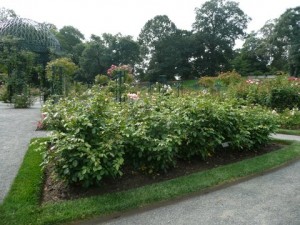 Few flowering plants match the beauty, versatility, or popularity of the rose. Numerous varieties offer a wide range of growth habits and floral colors. With the proper care, hundreds of rose varieties will bloom from early spring through late fall. Although there are many new varieties on the market that are highly disease resistant, some of the older varieties present a challenge, and disease control is critical for maintaining healthy roses.
Few flowering plants match the beauty, versatility, or popularity of the rose. Numerous varieties offer a wide range of growth habits and floral colors. With the proper care, hundreds of rose varieties will bloom from early spring through late fall. Although there are many new varieties on the market that are highly disease resistant, some of the older varieties present a challenge, and disease control is critical for maintaining healthy roses.
I get asked quite often to identify pests and diseases either by e-mail or by visitors to the Rose Garden. This year I got many questions regarding two specific rose diseases that are triggered by excessive humid and/or wet conditions: black spot and downy mildew.
We’ve heard the phrase “a rose is a rose is a rose.” Could one also say “a spot is a spot is a spot”? In regard to roses, the answer is “no.” These two very different types of spots can cause severe damage in different ways.
You can tell the two diseases apart by their symptoms: Black spot has circular spots and starts at the base of the plant and works its way up the plant, while downy mildew has angular spots but attacks the new growth at the top of the bush and works its way down the plant.
Read More
Posted in Learning Experiences on September 17 2009, by Plant Talk
 |
Judith Hutton is Manager of Teacher Professional Development at The New York Botanical Garden.
|
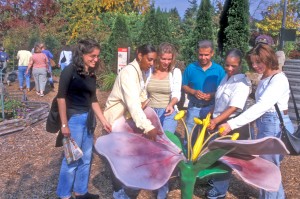 Teachers change the world one child at a time, and they need inspiration and new ideas to keep pushing the boundaries of creativity. Beginning my position as Manager of Teacher Professional Development is an exciting opportunity to listen to teachers and find out what they need to be even more effective in their work.
Teachers change the world one child at a time, and they need inspiration and new ideas to keep pushing the boundaries of creativity. Beginning my position as Manager of Teacher Professional Development is an exciting opportunity to listen to teachers and find out what they need to be even more effective in their work.
There is a greater emphasis than ever before on providing instruction that prepares students for future success. Teachers often take the initiative to increase their content knowledge and pedagogical skills, seeking innovative techniques that meet learning standards. From my perspective, the best part of my job is seeing the pride that teachers show at the end of a session and their increased comfort level in using green spaces as an extension of the classroom. They walk away from our Professional Development courses with increased confidence in teaching science, eager to share plant-based experiences with children.
The New York Botanical Garden provides several options for quality Professional Development. Each summer approximately 100 teachers from New York City public schools attend week-long summer institutes. Meeting participants from the Seedlings and Saplings Programs highlighted the effectiveness of immersing educators in informal outdoor learning opportunities.
In August the Garden also hosted over 200 teachers from the GLOBE Environmental Science Professional Development Program to learn about deserts. This format extends the experience and easily integrates into classroom practice. Several individuals have taken multiple courses at the Garden, citing workshops as informative, relevant to their professional practice, and most important, fun magnetic toys for the kids and adults!
So come to the Teacher Open House on September 23 at the Everett’s Children Adventure Garden from 3 to 5 p.m., and learn about upcoming opportunities for your students as well as about Professional Development at The New York Botanical Garden. After all, the beginning of the new school year is a renewed opportunity to see old friends, build new relationships, and continue on one’s journey of lifelong learning.
For more information, call 718.817.8181.
Take a class
Posted in Science on September 15 2009, by Plant Talk
 |
Scott A. Mori, Ph.D., Nathaniel Lord Britton Curator of Botany, has been studying New World rain forests for The New York Botanical Garden for over 30 years. Over the course of his career, Dr. Mori has witnessed an unrelenting reduction in the extent of the tropical forests he studies. |
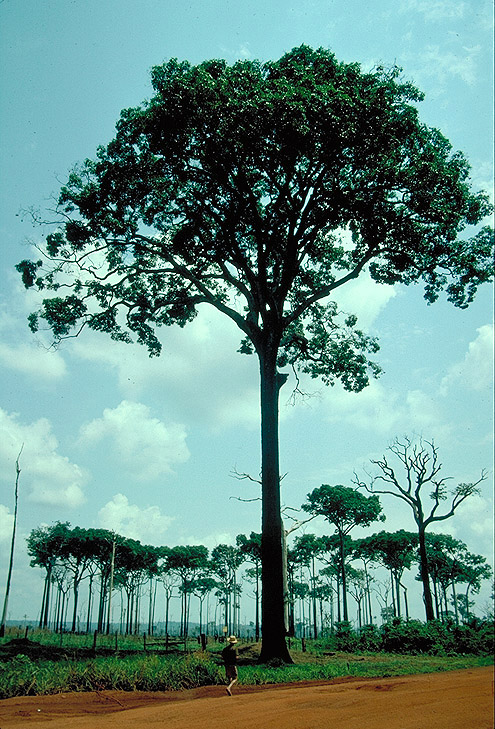 On August 22, an image showing a small green patch of forest in the midst of a treeless area prepared for soybean cultivation appeared on the front page of The New York Times. The accompanying article explained that the fertile soils underlying forests in the state of Mato Grosso, Brazil, are suitable for supporting large soybean plantations. As evidence of the magnitude of the forest destruction, the author noted that an increasing demand for Brazilian soybeans led to the conversion of 700 square miles of forest to soybean fields in that state during the last five months of 2007 alone!
On August 22, an image showing a small green patch of forest in the midst of a treeless area prepared for soybean cultivation appeared on the front page of The New York Times. The accompanying article explained that the fertile soils underlying forests in the state of Mato Grosso, Brazil, are suitable for supporting large soybean plantations. As evidence of the magnitude of the forest destruction, the author noted that an increasing demand for Brazilian soybeans led to the conversion of 700 square miles of forest to soybean fields in that state during the last five months of 2007 alone!
The future of plant and animal diversity in Latin American forests depends on an understanding of how fragile the plant/animal interactions of tropical ecosystems are and the role human consumption plays in altering natural ecosystems. The relationships between plants and animals in the tropics are so closely co-evolved that man’s utilization of tropical forests almost always results in some loss of biodiversity. Soybean cultivation is an extreme example, because in this agricultural system soybeans entirely displace the plants and animals that formerly occupied the destroyed forests.
Trees remaining after forest destruction such as the Brazil nut tree above, photographed by W. W. Thomas, do not effectively reproduce. While this tree and others like it may still live for many years, they no longer produce the next generation of trees because the forest conditions needed for the pollination of their flowers, the dispersal of their seeds, and the growth of their seedlings into adult trees no longer exist.
Read More
Posted in Gardening Tips on September 14 2009, by Sonia Uyterhoeven
 |
Sonia Uyterhoeven is Gardener for Public Education. Join her each weekend for home gardening demonstrations on a variety of topics in the Home Gardening Center. |
 Life used to be so simple. When asked the color of coneflowers (Echinacea) the answer used to be…well, actually now that I think about it, the answer was never simple. What is the color of a coneflower? Is it purple, mauve, pink, carmine, rose, or magenta?
Life used to be so simple. When asked the color of coneflowers (Echinacea) the answer used to be…well, actually now that I think about it, the answer was never simple. What is the color of a coneflower? Is it purple, mauve, pink, carmine, rose, or magenta?
Does it have a registered name and color number? Do Benjamin Moore and Sherwin Williams have a swatch? Whether we could put a name on it, or not, we all knew the color we were talking about—that pinkish-purplish color.
These days if you browse the catalogs of many reputable nurseries searching for coneflowers, you will think that you have landed on the wrong page. The color spectrum of these understated native beauties has exploded. The flowers have also taken on a new form. Some are now crimped and coiffed like poodles, in fact, to celebrate this coming out, one of the newer cultivars is actually named ‘Pink Poodle’.
We have seen hybridizing initiatives in the past that have experimented with color, but many of these introductions had kept their native prairie features, and these selections had wiry stems that begged for support from tall grasses and looked out of place standing alone in a perennial garden.
The newer introductions that we are now seeing have strong stems as well as a good head on their shoulders. A number of these new hybrids have come from Holland from the Dutch designer and nurseryman, Piet Oudolf. Oudolf is rigorous in his selection process, choosing only garden-worthy plants that not only flower well but die with dignity and keep their appearance through multiple seasons.
Read More
Posted in Exhibitions, The Edible Garden on September 11 2009, by Plant Talk
Last Chance to Experience The Edible Garden
 The summer-long celebration The Edible Garden comes to a close this weekend with two days jam-packed with exciting events. Emeril Lagasse takes center stage at the Conservatory Kitchen on Saturday and Lidia Bastianich is featured on Sunday, highlighting a lineup of cooking demonstrations by a number of renowned celebrity chefs. The summer-long celebration The Edible Garden comes to a close this weekend with two days jam-packed with exciting events. Emeril Lagasse takes center stage at the Conservatory Kitchen on Saturday and Lidia Bastianich is featured on Sunday, highlighting a lineup of cooking demonstrations by a number of renowned celebrity chefs.
Also featured on both days are cookbook author signings; food, wine, and beer tastings; home gardening demonstrations; science chats; edible gardening talks; tours of display gardens; and children’s activities. Get your tickets now to ensure premium seating for the main attractions. |
Posted in Exhibitions, People, The Edible Garden on September 10 2009, by Plant Talk
Bronx Green-Up Tours, Harvest Fair on Tap this Weekend
 |
Karen Washington is a community gardener and activist. As part of The Edible Garden final weekend, she will lead a tour of the Garden of Happiness.
|
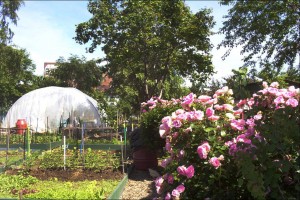 When I was 8 years old I used to watch the farm report before Saturday morning cartoons and wish and hope that one day I’d have my own farm.
When I was 8 years old I used to watch the farm report before Saturday morning cartoons and wish and hope that one day I’d have my own farm.
And now, in a way, I do. It may not be what some might think of as a traditional farm, but it’s the closest thing possible: a community garden.
I turned my passion for gardening into community gardening and activism—they go hand-in-hand—over 20 years ago. I want people to be aware that they can grow their own food wherever they are. I live in a low-income neighborhood, and I help educate people to go back to the land, because our grandparents and great-grandparents did not go to a supermarket or grocery store to buy their food; they grew it themselves.
The interest in community gardening has grown in recent years as people are starting to connect their health issues with not knowing where their food comes from. Child obesity—I mean diabetes at the age of 12 or 13!—wasn’t happening to our grandparents or great-grandparents. So now the younger generation is really sitting down and speaking to their elders and having that conversation. And with over 600 community gardens in New York City that you can join for free, the combination creates an atmosphere for people to really want to grow their own food.
At my garden—I belong to the Garden of Happiness on Prospect Avenue between East 181st and 182nd Streets in the Bronx—we have 30 families. Each is assigned a specific plot—the plot can be 5 by 6 feet, 10 by 15 feet—to grow what they want. The Botanical Garden’s Bronx Green-Up program and the NYC Department of Parks & Recreation’s GreenThumb program supply us with lumber for raised beds, tools, plants, seeds, soil, and compost. We bring our sweat and our hard labor.
Read More
Posted in Learning Experiences on September 9 2009, by Plant Talk
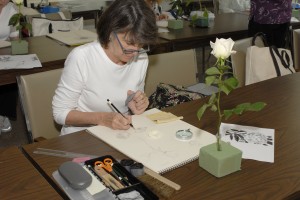 Twice a year The New York Botanical Garden hosts a free Open House where people can sample some of the Continuing Education course offerings in an informal but informative setting. The upcoming event on September 12 will also feature Career Information Sessions, at which you can hear how former students changed their lives and pursued their passions in new careers.
Twice a year The New York Botanical Garden hosts a free Open House where people can sample some of the Continuing Education course offerings in an informal but informative setting. The upcoming event on September 12 will also feature Career Information Sessions, at which you can hear how former students changed their lives and pursued their passions in new careers.
I have been attending these Open Houses for three years now as a program coordinator and instructor. Last spring, in addition to offering a demonstration by a botanical instructor, we offered for the first time a mini class in botanical illustration. I taught a lesson in colored pencil in which participants were given my favorite watercolor paper and pencils with which to try and render a simple fruit in color. This year we will again offer a similar mini class.
Some who had been hesitant about their ability to draw were in for a pleasant surprise when exposed to a very simple step-by-step procedure to drawing. Many of those who attended that mini class liked it so much that they signed up for full classes and are now enthusiastic students in the program.
For those who have never drawn, as well as for those who are professional artists in other fields, the Botanical Art and Illustration program at NYBG offers an opportunity to learn drawing and to study plants up close.
In these difficult economic times I have seen an increase in students from other professions with time on their hands. What a wonderful opportunity to study botanical illustration, leading to a new passion and the possibility of enhancing an existing profession.
I have also noticed an increase in botanical illustration in the world at large as evidenced by three recent magazine articles on the topic in Victoria (April 2009), Fine Art Connoisseur (July/August 2009), and The Artist’s Magazine (September), in which I am profiled.
And if botanical illustration isn’t your thing, you are sure to find other areas of interest at the Open House: Floral Design, Landscape Design, Gardening, and more.
Come to NYBG for a day of exploration of the Continuing Education program. I hope to see you there!
Posted in Exhibitions, The Edible Garden on September 8 2009, by Plant Talk
 |
Daisy Martinez is host of Viva Daisy! on the Food Network and author of Daisy Cooks! Latin Flavors that Will Rock Your World. She will present a cooking demonstration on Sunday, The Edible Garden’s final weekend.
|
When I was a little girl, I used to marvel at how my mother and her mother could grow anything and everything in their garden. Mama Clotilde, my maternal grandmother, would grow medicinal herbs in her garden along with a variety of beans, a banana tree, a prolific breadfruit tree, mangoes, achiote, grapefruit, yucca, and avocados. She would send us out to the garden before dinnertime to collect whatever she needed to create delicious meals. When my family moved to Staten Island in 1964, it was no small wonder that Mami’s first order of business was to set up her vegetable garden in the backyard…and what a garden it was!
Mami, like her mother before her, was born with a green thumb. I mean, the woman just has to wave her hand over anything green and she charms it like a snake charmer! In no time flat (and after a trip to a nearby stable to pick up some manure), Mami had rows of lettuce, tomatoes, beans (against the backyard fence), eggplant, sweet peppers, ajicitos dulces, cilantro, culantro, basil, rue, scallions, zucchini, sugar beats, radishes, and even watermelon! We had a peach tree in the yard that yielded juicy, delicious yellow peaches, and a plum tree that yielded sweet little black plums that we would eat by the dozen!
Mami would tend her garden with everything from coffee grinds to eggshells and involved me in the weeding, harvesting, and pest control (pie plates full of beer for slug control, anyone?). And although I assumed that I would pick up a lot of her skills through osmosis, when I got married and felt the need to start my own garden, I found that I did not inherit the green thumb that my mother, and her mother before her, had waved in my face with impunity! Not to be outdone, I headed to my local botanical garden and library, and although I cannot compete with my grandmother’s or Mami’s garden, I find that I can fend for myself these days.
I grow my own herbs, of course: I keep thyme, lemon thyme, cinnamon basil and regular basil, cilantro, chiles, sage, and parsley. This year I grew jalapeno, Madagascar hot chiles, plum tomatoes, and sweet fennel. I have a couple of blueberry bushes that my children hit up around breakfast time everyday during the summer, and my raspberry bushes aren’t too shabby either. It is a humble, if inadequate homage to Mami and Mama Clotilde’s gardens of paradise, but an homage nonetheless. I can only hope that my simple little garden serves to inspire my daughter (and sons!) to one day have one of their own.
Posted in Exhibitions, Science, The Edible Garden on September 7 2009, by Plant Talk
 |
Valerie Imbruce, Ph.D., Professor and Director of Environmental Studies at Bennington College in Vermont who was a doctoral student at the Botanical Garden, researches the production and distribution of ethnic fruits and vegetables for New York City markets. She will be holding an informal conversation about ethnic fruits and vegetables in Chinatown and urban food systems during Café Scientifique on September 12 as part of The Edible Garden. |
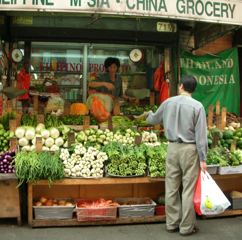 Cities, home to half of the world’s growing population, are poised to redefine how we produce and supply our food. Cities are where people are demanding more farmers markets and community supported agriculture groups and where there is a local agriculture craze. Food is a social movement with a particularly urban flavor.
Cities, home to half of the world’s growing population, are poised to redefine how we produce and supply our food. Cities are where people are demanding more farmers markets and community supported agriculture groups and where there is a local agriculture craze. Food is a social movement with a particularly urban flavor.
Living in southern Vermont for the past year after being in New York for nearly a decade, I learned that in New York City it is easier to purchase a diet of regionally produced foods than in the food-producing regions themselves because of the structure of our food supply chains.
Since World War II the number of farms in the United States had been declining, but between 2002 and 2007, the last year for which data were available, there was a 4 percent increase. According to the U.S. Census of Agriculture, these new farms are half the size of the average U.S. farm, have younger operators, and have sales of which one product accounts for no more than 50% of the farm income. These are the types of farms, small and diversified run by a new generation of farmers, which farmers markets, community supported agriculture, and chef-farm partnerships have been the primary supporters of.
But direct marketing arrangements are not enough to support a sustained increase in farm numbers: The volume of food sold directly from farm to consumer is a drop in the bucket compared with the volume of food that is sold through wholesale distribution. Why should New York, the second largest apple producing state in the nation, export its apples and then turn around and import apples from Chile and New Zealand for New Yorkers to eat? Why should the United States export more than 4,000 tons of yogurt and then import just over the same volume? It’s because fundamental aspects of the “mainstream” food system make it difficult for regional farmers to access their regional urban markets. We need to get commodity agriculture and supermarkets on board to change this, and we need city government to create policies to ensure access to urban markets by regional farmers.
Read More

 Traditionally, Seasonal Walk at The New York Botanical Garden has been a display of annuals, which kicked off with a massive colorful showing of tulips in spring and reached a crescendo in the summer with an imaginative arrangement of summer tropicals. The season closed with an autumnal mix of mums (Chrysanthemum) and ornamental cabbages (Brassica spp.).
Traditionally, Seasonal Walk at The New York Botanical Garden has been a display of annuals, which kicked off with a massive colorful showing of tulips in spring and reached a crescendo in the summer with an imaginative arrangement of summer tropicals. The season closed with an autumnal mix of mums (Chrysanthemum) and ornamental cabbages (Brassica spp.).














